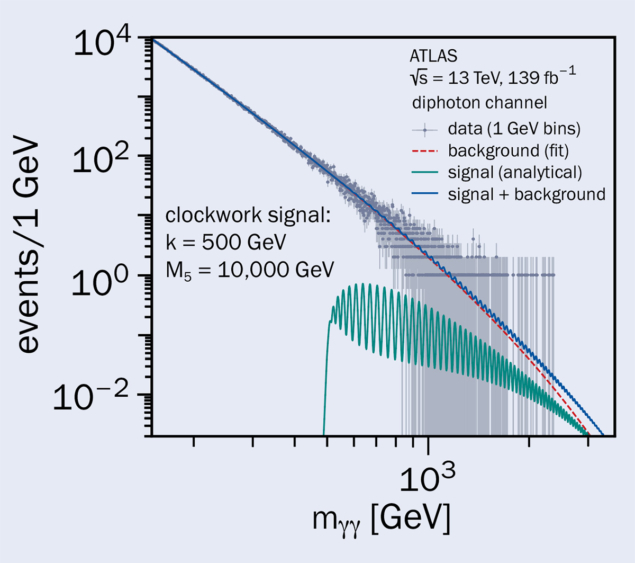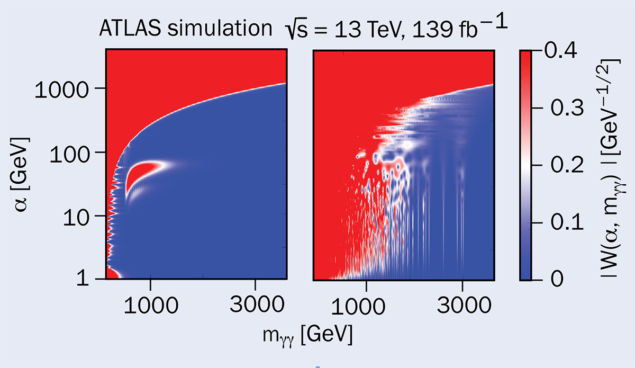A report from the ATLAS experiment.

New physics may come at us in unexpected ways that may be completely hidden to conventional search methods. One unique example of this is the narrowly spaced, semi-periodic spectra of heavy gravitons predicted by the clockwork gravity model. Similar to models with extra dimensions, the clockwork model addresses the hierarchy problem between the weak and Planck scales, not by stabilising the weak scale (as in supersymmetry, for example), but by bringing the fundamental higher dimensional Planck scale down to accessible energies. The mass spectrum of the resulting graviton tower in the clockwork model is described by two parameters: k, a mass parameter that determines the onset of the tower, and M5, the five-dimensional reduced Planck mass that controls the overall cross-section of the tower’s spectrum.
At the LHC, these gravitons would be observed via their decay into two light Standard Model particles. However, conventional bump/tail hunts are largely insensitive to this type of signal, particularly when its cross section is small. A recent ATLAS analysis approaches the problem from a completely new angle by exploiting the underlying approximate periodicity feature of the two-particle invariant mass spectrum.
Graviton decays with dielectron or diphoton final states are an ideal testbed for this search due to the excellent energy resolution of the ATLAS detector. After convolving the mass spectrum of the graviton tower with the ATLAS detector resolution corresponding to these final states, it resembles a wave-packet (like the representation of a free particle propagating in space as a pulse of plane-wave superposition with a finite momenta range). This implies that a transformation exploiting the periodic nature of the signal may be helpful.

Figure 1 shows how a particularly faint clockwork signal would emerge in ATLAS for the diphoton final state. It is compared with the data and the background-only fit obtained from an earlier (full Run 2) ATLAS search for resonances with the same final state. As an illustration, the signal shape is given without realistic statistical fluctuations. The tiny “bumps” or the shape’s integral over the falling background cannot be detected with conventional bump/tail-hunting methods. Instead, for the first time, a continuous wavelet transformation is applied to the mass distribution. The problem is therefore transformed to the “scalogram” space, i.e. the mass versus scale (or inverse frequency) space, as shown in figure 2 (left). The large red area at high scales (low frequencies) represents the falling shape of the background, while the signal from figure 1 now appears as a clear, distinct local “blob” above mγγ = k and at low scales (high frequencies).
The strongest exclusion contours to date are placed in the clockwork parameter space
With realistic statistical fluctuations and uncertainties, these distinct “blobs” may partially wash out, as shown in figure 2 (right). To counteract this effect, the analysis uses multiple background-only and background-plus-signal scalograms to train a binary convolutional neural-network classifier. This network is very powerful in distinguishing between scalograms belonging to the two classes, but it is also model-specific. Therefore, another search for possible periodic signals is performed independently from the clockwork model hypothesis. This is done in an “anomaly detection” mode using an autoencoder neural-network. Since the autoencoder is trained on multiple background-only scalograms (unlabelled data) to learn the features of the background (unsupervised learning), it can predict the compatibility of a given scalogram with the background-only hypothesis. A statistical test based on the two networks’ scores is derived to check the data compatibility with the background-only or the background+signal hypotheses.
Applying these novel procedures to the dielectron and diphoton full Run 2 data, ATLAS sees no significant deviation from the background-only hypothesis in either the clockwork-model search or in the model-independent one. The strongest exclusion contours to date are placed in the clockwork parameter space, pushing the sensitivity to beyond 11 TeV in M5. Despite the large systematic uncertainties in the background model, these do not exhibit any periodic structure in the mass space and their impact is naturally reduced when transforming to the scalogram space. The sensitivity of this analysis is therefore mostly limited by statistics and is expected to improve with the full Run 3 dataset.
Further reading
ATLAS Collab. 2023 arXiv:2305.10894.
G F Giudice et al. 2018 JHEP 6 009.








